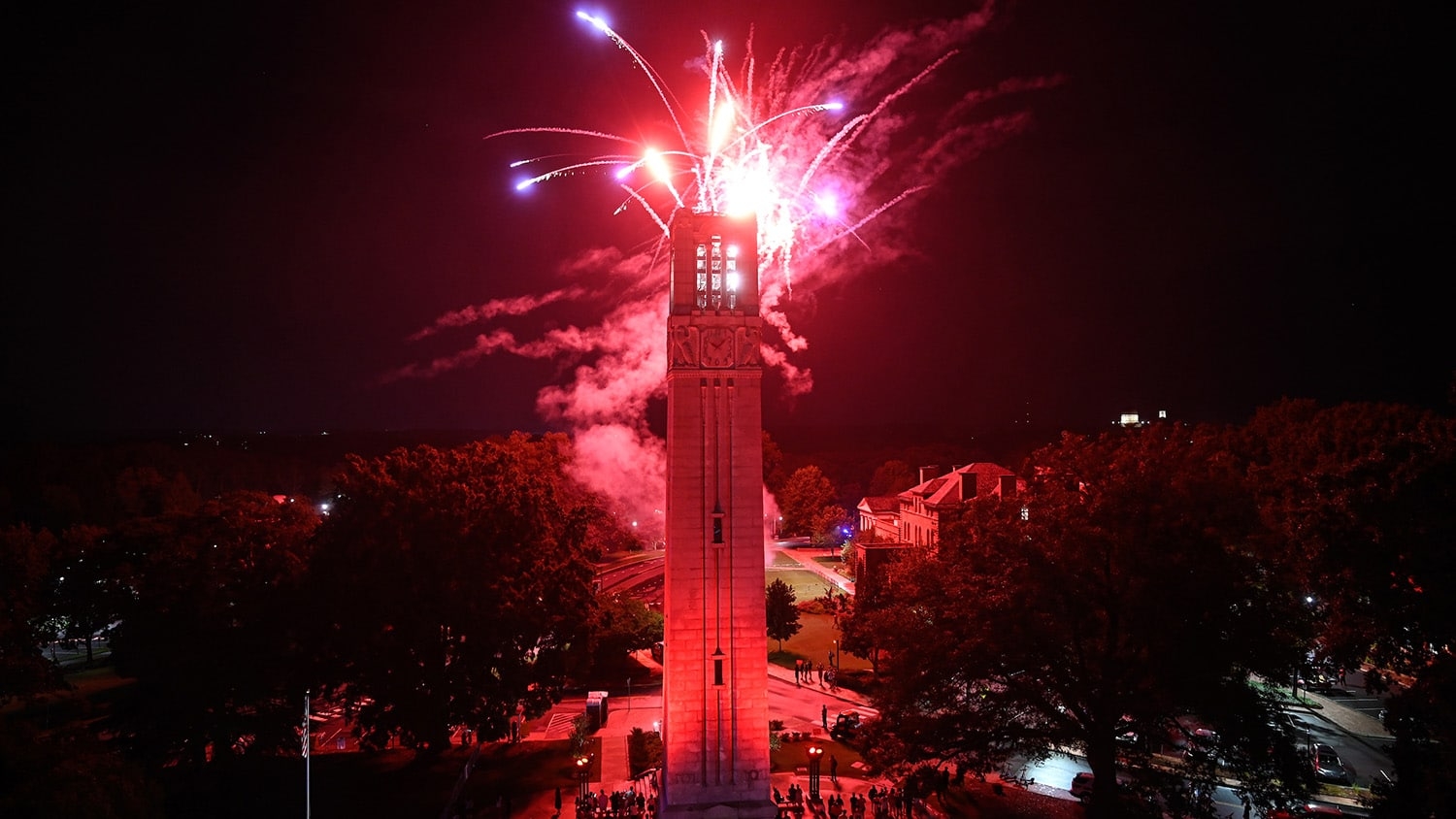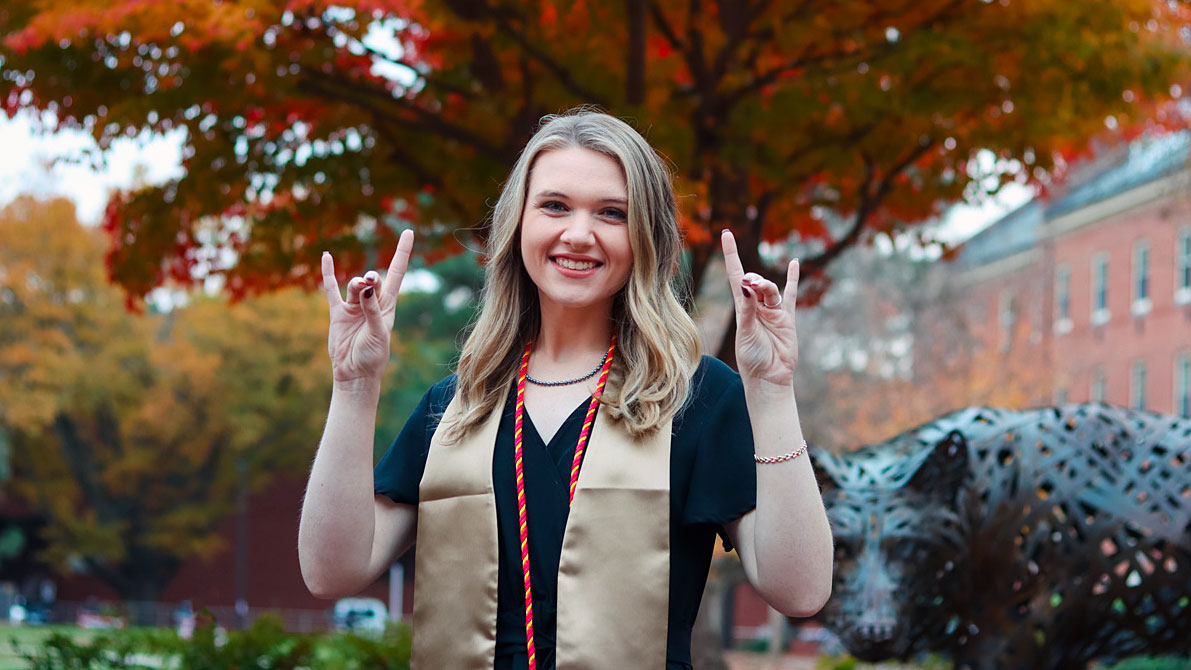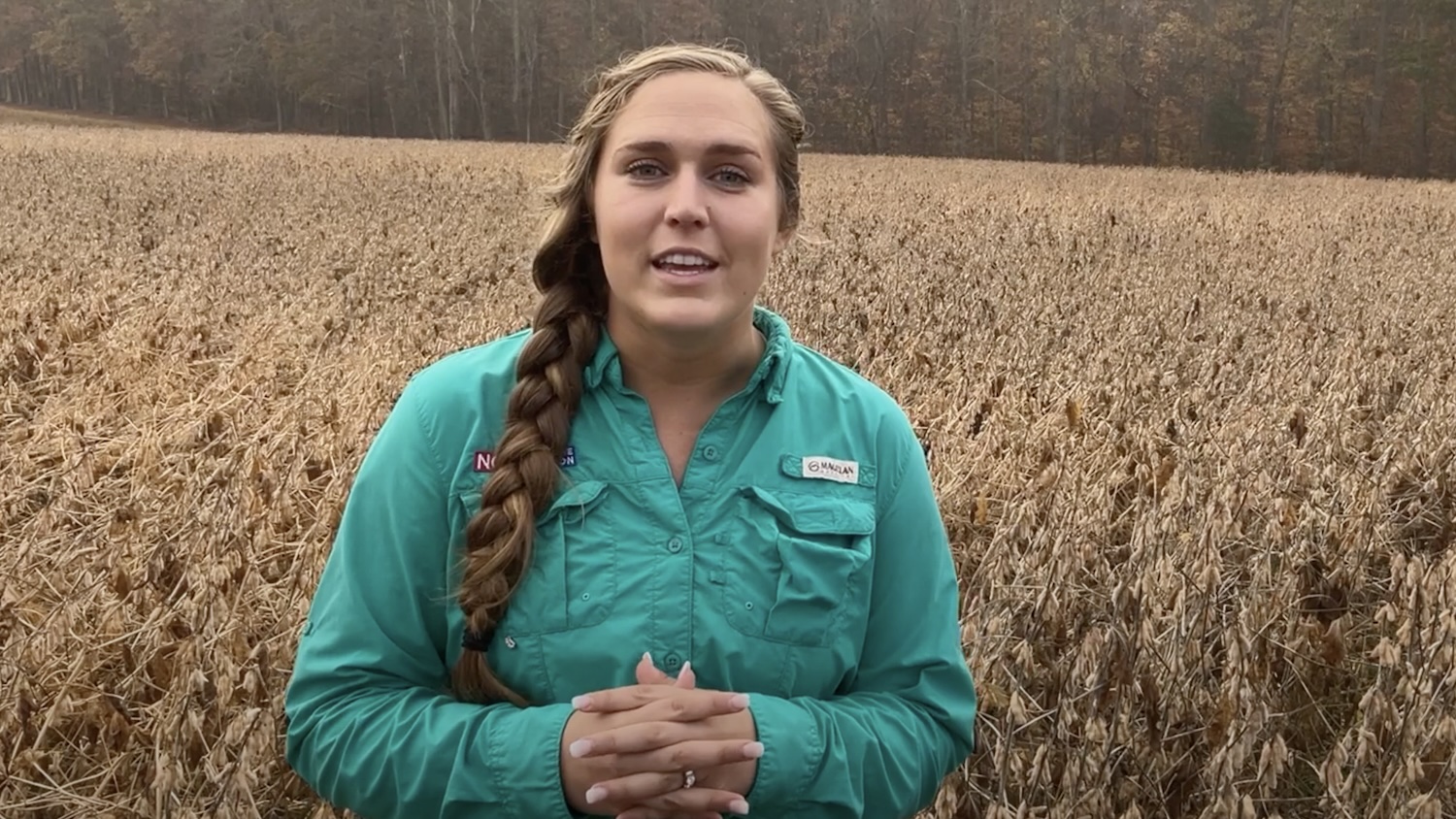Growing Giants
Imagine a pumpkin putting on 20, 40 or even 60 pounds a day. It happens!
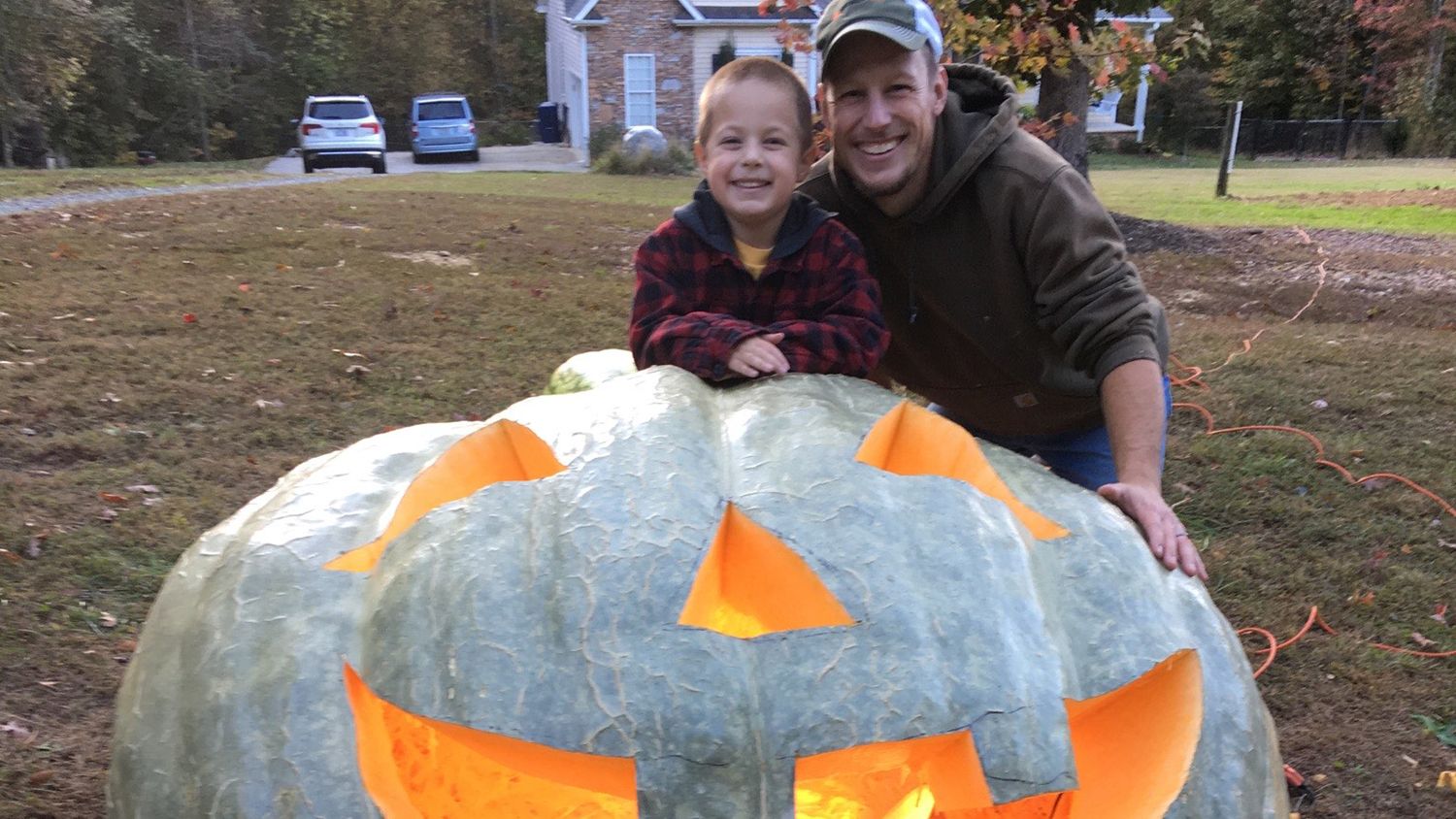
With the North Carolina State Fair cancelled this year, the public won’t get to witness the Great Pumpkin and Watermelon Weigh-Off, but in this episode of Farms, Food and You, three North Carolinians talk about the art, the science and the fun of growing giants.
Download file | Download transcript (PDF) | RSS feed | Subscribe on Apple Podcasts | 14m:25s
Our Guests
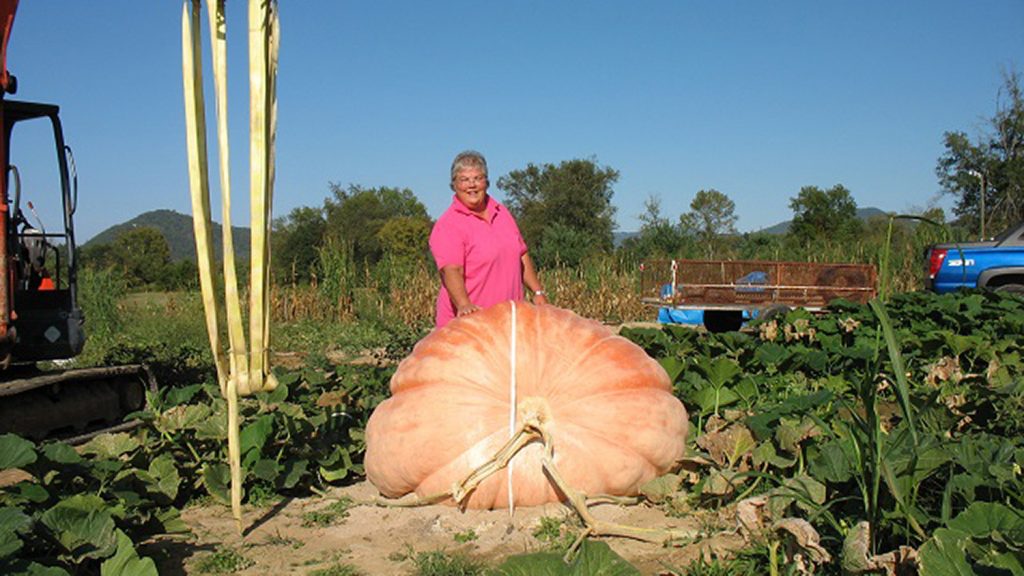
Susie Zuerner of Arden, North Carolina, is so passionate about the art and science of growing giant produce that she’s volunteered for years to help organize watermelon and pumpkin weigh-offs at the North Carolina State Fair. Her biggest watermelon weighed 239 pounds, and her biggest pumpkin was over 994 pounds.
Elijah Meck of Randleman, North Carolina, works as a crop protection scientist for a major agricultural biotechnology company. He’s been growing giants since he was a graduate student studying entomology at North Carolina State University, where he earned his Ph.D. in 2010. He started out growing pumpkins and branched out watermelons, tomatoes, gourds, sunflowers and more. He represents the Southern United States on the Great Pumpkin Commonwealth.
Billy Caudle is an avid gardener and the 4-H youth program assistant in Currituck County, North Carolina. The city councilor in Elizabeth City and retired senior manager with FedEx joined Currituck’s Cooperative Extension staff in 2018 to oversee the 4-H day camping and community service and restitution programs.
Brandon Huber is a Ph.D. candidate at North Carolina State University who’s been a horticultural enthusiast since his childhood in Pennsylvania. As a master’s student, he worked on breeding stevia plants, and during his doctoral studies, he looked at how using certain lighting could improve the growth of tomato seedlings indoors. He also owns a rare corpse flower that’s attracted thousands of visitors to NC State eager to watch — and smell — the flower’s beautiful but stinky opening.
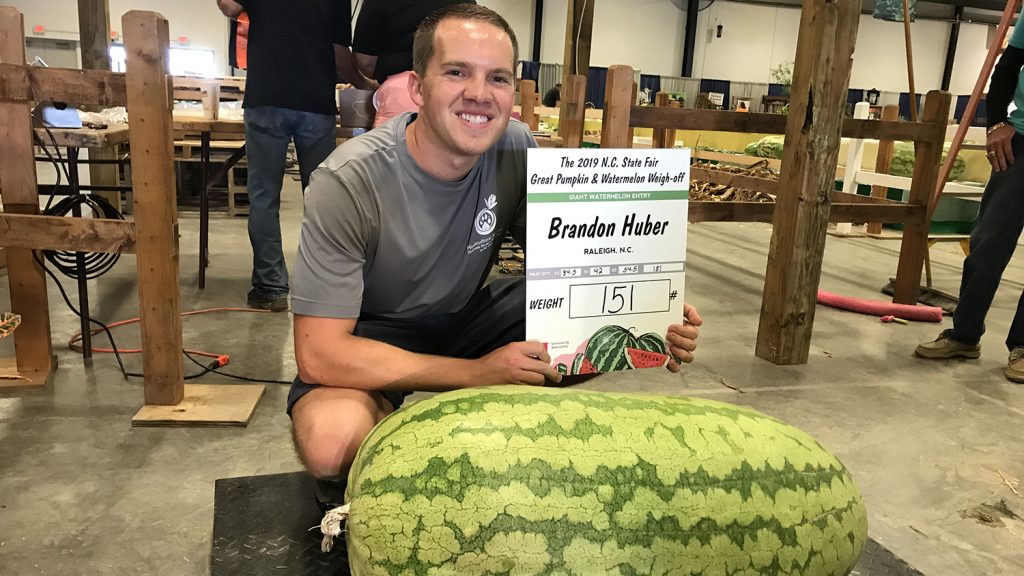
Transcript
[Music]
Dee Shore:
Most years around this time, hundreds of thousands of people pack the North Carolina State Fairgrounds in search of fun. But this year, of course, there’ll be no deep-fried anything, no midway rides, no Howling Cow ice cream, no stage shows, no craft exhibits, no fireworks.
I’m Dee Shore, from North Carolina State University’s College of Agriculture and Life Sciences, and one of the things I’ll miss about the fair is seeing the ginormous pumpkins and watermelons. There will be a Great Pumpkin and Watermelon Weigh-Off this year, but the contest will be open only to competitors and contest organizers. The winners will be displayed at the fairgrounds after the contest on Oct. 10, but there will be no ohhing and ahhing crowds in the Expo Center.
So to get my fill of big produce this year, I caught up with some of the regular weigh-off competitors to learn more about the art and the science of their hobby of growing giants.
[MUSIC]
Dee Shore:
Susie Zuerner of Arden, North Carolina, is one reason the Great Pumpkin and Watermelon Weigh-Off is being held this year, as it has every year since 2014. She got involved in growing plants as a kid, and her passion for pumpkins, especially big ones, has grown over decades.
Susie Zuerner:
I’ve loved pumpkins since I was a teenager. Don’t ask me why, but I like growing things. I started a couple of plants and put them in my mother’s flower beds and much to my father’s frustration, I let them grow out into the yard and told him he couldn’t mow over my pumpkin plants. I got a couple of nice jack-o-lanterns and even turned one of them into pumpkin pie and decided since that time that Libby’s has got a much better idea. I’ve never done that again, but I’ve always liked pumpkins.
Dee Shore:
Zuerner started growing pumpkins competitively back in 2009, when she produced a 250-pounder.
Susie Zuerner:
At that point I was hooked.
Dee Shore:
So hooked that she was growing more pumpkins than there were weigh-offs in North Carolina and nearby states that were sanctioned by the Great Pumpkin Commonwealth. The GPC, as it’s called, holds competitions, sets rules and recognizes championship pumpkins, melons and other fruits from around the world.
While the State Fair has long featured big pumpkin exhibits, Zuerner and a small group of growers convinced the state agriculture department to launch a GPC-sanctioned competition six years ago.
With its cash prizes, the State Fair competition now attracts up to 50 entries from around the state and beyond each year, and the numbers on the scales have been going up. Last year the winner of the watermelon contest, Andrew Vial of Liberty, also grew the largest watermelon in the world at 341 and a half pounds. And Danny Vester of Spring Hope set a state record with his 1,506.5-pound pumpkin.
Zuerner has grown a pumpkin that was just shy of 1,000 pounds, and that, she says, was no small feat.
Susie Zuerner:
I want to tell you something, getting anything to grow over a thousand pounds is a lot of work. In the wintertime, a lot of us will hit the academic journals, university abstracts and start looking at research that might be applicable. And if you think you know it all, you’re going to get humbled pretty quick.
Dee Shore:
Elijah Meck of Randleman agrees. He says that growing giants is part science, part hard work and part luck. Meck is an agricultural scientist, and it’s no surprise that he emphasizes the science part of the growing equation.
Elijah Meck:
I’ll make maybe a couple of comparisons to commercial agriculture, even though we’re doing this on a microscale, comparatively. It really starts with soil health. So I always plant a cover crop in the fall – some rye, some hairy vetch, different things to help with the soil structure, keep the soil in place. Take a soil test, send that off for analysis to see where all my nutrient levels are, and that kind of dictates what my fertilizer program might look like the next year. So a lot of it comes down to soil and soil health.
The other big factor is genetics. Growers in general make a lot of decisions around seed and genetics and what they’re going to grow, what yields the best for them. There’s a lot of different seeds out there. Actually in the giant pumpkin world, most of the seeds have a pedigree behind them. You can actually follow the crosses within the variety back for many years.
Dee Shore:
In North Carolina, most growers start their plants indoors in late April or early May, then transplant them outdoors. A giant pumpkin can take up 900 or more square feet of space, so most competitors grow just one or two each year. The vines grow rapidly in June and the growers carefully train them, and in July they’ll hand pollinate the flowers.
Elijah Meck:
And then, just taking care of it. It requires a lot of time. You got to maintain a good fertilizer program. You got to control your insects and diseases, got to give it a lot of water, because a lot of it’s water weight, at the end of the day.
Dee Shore:
Meck says it’s also important to make sure your soil doesn’t dry out.
Elijah Meck:
If you do and you get a significant rainfall, you tend to get a surge of water going into the fruit and it can actually be so much that the fruit will crack. So if you keep a constant moisture there, it’s less likely to surge. And just try to keep everything healthy and happy. And you just, you hope for the best and then do the best you can. And hopefully you come away with a giant.
Dee Shore:
Meck has, in fact, come away with several giants. In 2017, he grew his biggest pumpkin, a North Carolina record breaker at the time at 1,458 and a half pounds. This year, he’s had success with other plants. He grew two tomatoes that topped four and a half pounds – that’s more than a two-liter bottle of soda – and a sunflower that grew to more than 21 feet – taller than an adult giraffe.
Elijah Meck:
To watch these plants and these fruits grow is part of the fascination. So while it’s a lot of work, you’re seeing that work pay off almost on a daily basis once you get a fruit set. So some of the pumpkins, especially the big ones up North, they’re putting on 50, 60 pounds in a 24-hour period. Even here in the South, we can get gains of over 40 pounds a day, so you can literally watch them grow. I can leave for work in the morning and come back home in the evening, and I can tell that the fruit has grown.
I like to grow big. I like to grow bigger than I’ve grown before. But the thrill that somebody gets out of seeing a 300-pound pumpkin or a 500-pound pumpkin – that’s why I do it. I like to see people’s reaction.
Dee Shore:
Billy Caudle is working to harness that sort of fascination to inspire young people he works with. When the COVID-19 pandemic hit, the 4-H program assistant organized a Giant Pumpkin and Watermelon Contest in Currituck County.
Billy Caudle:
We had 18 participants, which I thought was really cool, just trying to get people out of the house and doing things during the quarantine. A lot of people were going stir crazy and looking for projects for their kids.
Dee Shore:
But the contest was about more than just keeping kids busy. Caudle often works with kids who don’t have a lot of resources and who are in the juvenile justice system. Growing big pumpkins and watermelons doesn’t require a lot of money, but it does require follow through. And Caudle says that it’s just one of many good things that can come from gardening.
Billy Caudle:
We’re always working with kids about healthy eating, healthy living, that kind of stuff, and a garden can be kind of the center for all kinds of things – taking responsibility, making good decisions. You can really go in a lot of different areas.
Dee Shore:
That’s been the case for Brandon Huber. Gardening has been central in Huber’s life since he was a kid in Philadelphia. His goal is to be a plant science professor, and as he approaches the end of his Ph.D. studies at NC State, he’s well on his way.
Huber devotes his spare time to raising giants. Last year, he brought a 151-pound watermelon to the fair, big enough to earn fifth place, and he took first place for a 150-plus pound bushel gourd. Growing the bushel gourd, he says, was actually easy.
Brandon Huber:
I grew it on the edge of my pumpkin patch last year, and I fed it like everything else in my patch, but I didn’t really fuss with the plant. It was super aggressive. It never wilted. It never complained much. It just was a very tough plant. I really appreciated it for its easygoing nature because, as I’m spending a lot of time with the pumpkins or watermelons, this thing is just always happy, and it’s just growing well.
Dee Shore:
Of course, growing giants is usually more complicated. Huber once had a 170-pound watermelon that he thought he could get to over 200 pounds, but a tarp that he’d erected to protect it from the heat fell down and landed on top of the fruit. The sun got the fallen tarp so hot that when Huber returned to the garden the next evening, the melon was cooked.
Brandon Huber:
There’s lots of risks in growing these things. And it’s all part of the fun. We all say it’s very stressful, especially in the last month or two before a weigh-off, because it’s, ‘Is this thing going to bust?’ ‘Is an animal going to come along and eat it?’ ‘Is a hurricane going to come through and just destroy the plant.’ It’s just so much, and you have some control, but you don’t have all of it.
Dee Shore:
In Zuerner’s case, disaster nearly struck one day when she was hauling a nearly 1,000-pound pumpkin down the interstate in the back of her truck.
Susie Zuerner:
I had this darn sedan pull up – just beep, beep, beep, beep. I’m in the righthand lane going five miles over the speed limit. This car pulls up beside me, just laying on the horn. And I look out and there’s somebody hanging out the window, pointing at the pumpkin, and I thought maybe there’s something wrong.
Dee Shore:
There wasn’t anything wrong. The sedan occupants just wanted to know if the pumpkin was real – and how it got that big. The next thing Zuerner knew, she was quickly coming up on a tractor trailer in her lane. She slammed on her brakes, just in time to avoid a wreck.
Susie Zuerner:
One thing I talk about with new growers and moving their pumpkins, you make sure that pallet that you have that pumpkin on is secured to your truck and that you have that pumpkin secured to the pallet so the pallet and the pumpkin and the truck are as one, because a 900- or 1,000-pound pumpkin will go through the back end of a truck and out the front windshield if you stop hard enough. The last thing that we want going through our head with a giant pumpkin on the back is pumpkin seeds.
Dee Shore:
Zuerner says that sharing such lessons is key to great-pumpkin-growing community. And it’s one of the things that keeps her, Meck and Huber coming back year in and year out to grower meetings and competitions. They say the community is supportive, especially when it comes to welcoming beginners. As Huber puts it:
Brandon Huber:
It’s a really tight community, and it’s not even on a local scale. It’s more of a national scale. We’re all friends basically on Facebook, and there’s this forum called bigpumpkins.com. And it’s a wealth of knowledge. The world-record growers are on there talking about stuff and posting journals and sharing things that are going on in their patch day to day. It’s super informative, and it also fuels that passion to strive for more.
Dee Shore:
That passion will undoubtedly keep these growers reaching for their personal best for years to come. So here’s to 2021 and the hope we’ll be able to join them next October at the North Carolina State Fair.
[Music]
Dee Shore:
Thanks for listening today, and we hope you’ll join us again for the next episode of Farms, Food and You. To learn more about the College of Agriculture and Life Sciences and our podcast, visit go.ncsu.edu/farms. While you’re there, share your thoughts. We’d love to get your ideas and to hear what topics you’d like for us to explore in the future.
- Categories:
